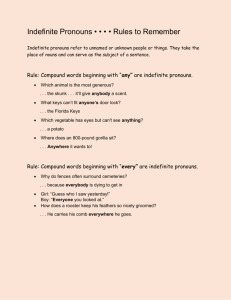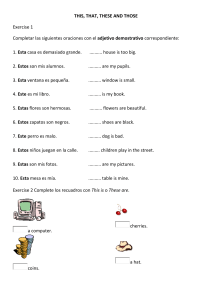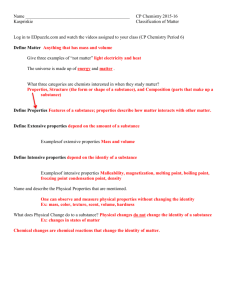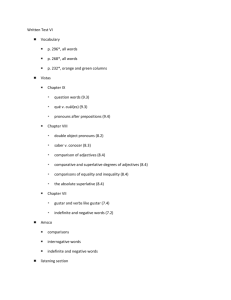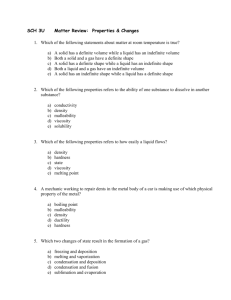24 Indefinite Integration
advertisement
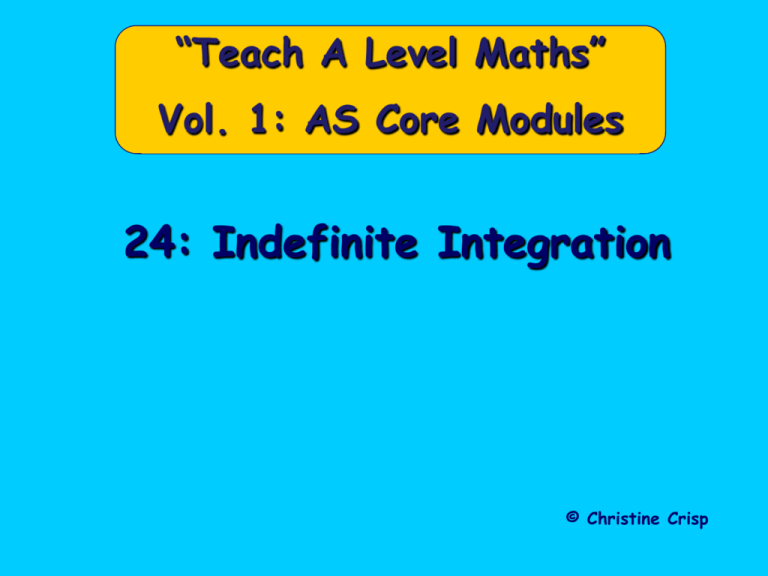
“Teach A Level Maths” Vol. 1: AS Core Modules 24: Indefinite Integration © Christine Crisp Indefinite Integration Module C1 Module C2 AQA MEI/OCR Edexcel OCR "Certain images and/or photos on this presentation are the copyrighted property of JupiterImages and are being used with permission under license. These images and/or photos may not be copied or downloaded without permission from JupiterImages" Indefinite Integration We first need to consider an example of differentiation e.g.1 Differentiate (a) (a) y x 2 3 y x2 3 (b) y x 1 dy 2x dx 2 Equal ! (b) y x 2 1 dy 2 x dx The gradient functions are the same since the graph of y x 2 1 is a just a translation of y x2 3 Indefinite Integration Graphs of the functions y x2 3 e.g. the gradient at x = 1 is 2 y x2 1 At each value of x, the gradients of the 2 graphs are the same dy 2x dx Indefinite Integration Indefinite integration is the reverse of differentiation If we are given the gradient function and want to find the equation of the curve, we reverse the process of differentiation BUT the constant is unknown So, dy 2x dx y x2 C C is called the arbitrary constant or constant of integration The equation y x 2 C forms a family of curves Indefinite Integration e.g.2 Find the equation of the family of curves which have a gradient function given by Solution: dy 6x 2 dx dy 6x 2 dx To reverse the rule of differentiation: y 6x 3 • • add 1 to the power divide by the new power Indefinite Integration e.g.2 Find the equation of the family of curves which have a gradient function given by Solution: dy 6x 2 dx dy 6x 2 dx To reverse the rule of differentiation: 2 6x3 C y y 2x C 31 3 • • add 1 to the power divide by the new power • add C Tip: Check the answer by differentiating Indefinite Integration The graphs look like this: The gradient function dy 6x 2 dx dy dx dy 6x 2 dx y 2x3 C ( Sample of 6 values of C ) y y 2x3 5 y 2x 3 Indefinite Integration e.g. 3 Find the equation of the family of curves with gradient function dy 3x 1 dx Solution: The index of x in the term 3x is 1, so adding 1 to the index gives 2. The constant 1 has no x. It integrates to x. 3x2 y xC 2 We can only find the value of C if we have some additional information Indefinite Integration Exercises Find the equations of the family of curves with the following gradient functions: 1. dy 3x2 4x dx 1 3 2 Ans : 3x 4x2 y C 21 1 3 2. dy 1 2 x x 1 dx 2 3. dy ( x 2)( x 3) dx Ans : y x3 2x2 C x3 x2 y xC 3 4 N.B. Multiply out the brackets first Indefinite Integration Exercises Find the equations of the family of curves with the following gradient functions: 1. dy 3x2 4x dx 1 3 2 Ans : 3x 4x2 y C 21 1 3 2. dy 1 2 x x 1 dx 2 3. dy ( x 2)( x 3) dx Ans : Ans : 3 2 y x3 2x2 C x3 x2 y xC 3 4 dy x2 x 6 dx x x y 6x C 3 2 Indefinite Integration Finding the value of C e.g.1 Find the equation of the curve which passes through the point (1, 2) and has gradient function given by dy 2 dx Solution: x x2 dy x2 x 2 dx 2 x x y 2x C 2 3 3 Indefinite Integration Finding the value of C e.g.1 Find the equation of the curve which passes through the point (1, 2) and has gradient function given by dy 2 dx Solution: x x2 dy x2 x 2 dx (1, 2) is on the curve: 6 is the common denominator 2 x x y 2x C 2 3 1 1 2 2 (1) C 3 2 3 1 1 2 2 C 3 2 1 C 6 So, 23 C 6 x3 x2 1 y 2x 3 2 6 Indefinite Integration Exercises 1. Find the equation of the curve with gradient function dy 1 which passes through the point ( 2, -2 ) x dx 2 2. Find the equation of the curve with gradient function dy ( x 1)( x 2) which passes through the point ( 2, 1 ) dx Indefinite Integration Solutions 1. dy 1 x dx 2 x2 y C 4 Ans: ( 2, -2 ) lies on the curve ( 2) 2 2 C 4 21 C So, 1 C 2 x y 1 4 Indefinite Integration Solutions 2. dy ( x 1)( x 2) dx dy x2 3x 2 dx x3 3x2 y 2x C 3 2 ( 2, 1 ) on the curve ( 2) 3 3( 2) 2 1 2( 2) C 3 2 35 8 C 1 64 C 3 3 x3 3x2 35 So, y 2x 3 2 3 Indefinite Integration Notation for Integration e.g. 1 We know that dy 2x dx 1 2x2 y C 21 Another way of writing integration is: 2 x dx x 2 C Called the integral sign We read this as “d x ”. It must be included to indicate that the variable is x In full, we say we are integrating “ with respect to x “. Indefinite Integration e.g. 2 Find (a) 3 dt (b) 3 dx Solution: (a) ( Integrate with respect to x ) 3 dx 3 x C 3 dt 3t C (b) ( Integrate with respect to t ) e.g. 3 Integrate x 3 x 2 2 x 1 with respect to x Solution: The notation for integration must be written We have done the integration so there is no integral sign x 3 x 2 2 x 1 dx 4 3 1 x x 2x2 xC 4 3 21 x4 x3 x2 x C 4 3 Indefinite Integration Exercises 1. Find (a) (b) 4t 3 x 2 4 x 2 dx 3 Ans : x 3 2 x 2 2 x C 8t 2 4t 3 dt 3 8 t Ans : t 4 2t 2 3t C 3 2. Integrate the following with respect to x: (a) x 2 3 x 2 Ans : (a) (b) (b) 4 x 3 9 x 2 6 x 7 3 2 x 3 x x 2 3 x 2 dx 2x C 3 2 3 2 4 x 9 x 6 x 7 dx x4 3x3 3x2 7x C Indefinite Integration Summary Indefinite Integration is the reverse of differentiation. A constant of integration, C, is always included. Indefinite Integration is used to find a family of curves. To find the curve through a given point, the value of C is found by substituting for x and y. There are 2 notations: dy e.g. 4x3 y x4 C dx e.g. 4 x 3 dx x 4 C Indefinite Integration Indefinite Integration The following slides contain repeats of information on earlier slides, shown without colour, so that they can be printed and photocopied. For most purposes the slides can be printed as “Handouts” with up to 6 slides per sheet. Indefinite Integration Indefinite integration is the reverse of differentiation If we are given the gradient function and want to find the equation of the curve, we reverse the process of differentiation BUT the constant is unknown So, dy 2x dx y x2 C C is called the arbitrary constant or constant of integration The equation y x 2 C forms a family of curves Indefinite Integration e.g. Find the equation of the family of curves which have a gradient function given by Solution: dy 6x 2 dx dy 6x 2 dx To reverse the rule of differentiation: 2 6x3 C y y 2x C 31 3 • • add 1 to the power divide by the new power • add C Tip: Check the answer by differentiating The graphs look like this: Indefinite Integration The gradient function dy 6x 2 dx dy dx dy 6x 2 dx y y 2x3 C ( Sample of 6 values of C ) y 2x3 5 y 2x 3 We can only find the value of C if we have some additional information Indefinite Integration Finding the value of C e.g.1 Find the equation of the curve which passes through the point (1, 2) and has gradient function given by dy 2 dx Solution: x x2 dy x2 x 2 dx (1, 2) is on the curve: 6 is the common denominator x2 x3 y 2x C 2 3 1 1 2 2 (1) C 3 2 1 1 2 2 C 3 2 1 C 6 So, 23 C 6 x3 x2 1 y 2x 3 2 6 Indefinite Integration e.g. 2 Find the equation of the family of curves with gradient function dy 3x 1 dx Solution: The index of x in the term 3x is 1, so adding 1 to the index gives 2. The constant 1 has no x. It integrates to x. 3x2 y xC 2 Indefinite Integration Notation for Integration e.g. 1 We know that dy 2x dx 1 2x2 y C 21 Another way of writing integration is: 2 x dx x 2 C Called the integral sign We read this as “d x ”. It must be included to indicate that the variable is x In full, we say we are integrating “ with respect to x “. Indefinite Integration Summary Indefinite Integration is the reverse of differentiation. A constant of integration, C, is always included. Indefinite Integration is used to find a family of curves. To find the curve through a given point, the value of C is found by substituting for x and y. There are 2 notations: dy e.g. 4x3 y x4 C dx e.g. 4 x 3 dx x 4 C
